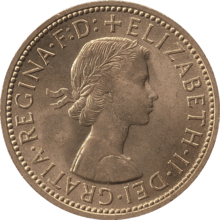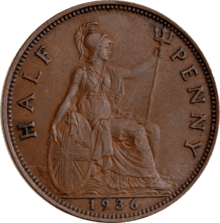Halfpenny (British pre-decimal coin)
| United Kingdom | |
| Value | 1/480 pound sterling |
|---|---|
| Mass | (1860–1967) 5.67 g |
| Diameter | (1860–1967) 25.48 mm |
| Edge | Plain |
| Composition |
(1672–1860) Copper (1860–1967) Bronze |
| Years of minting | 1672–1967 |
| Obverse | |
 | |
| Design | Profile of the monarch (Elizabeth II design shown) |
| Designer | Mary Gillick |
| Design date | 1953 |
| Reverse | |
 | |
| Design | Golden Hind (Britannia on earlier mintages) |
| Designer | Thomas Humphrey Paget |
| Design date | 1937 |
The British pre-decimal halfpenny (1⁄2d) coin, usually simply known as a halfpenny (pronounced /ˈheɪpəni/ HAY-pə-nee), historically occasionally also as the obol,[1] was a unit of currency that equalled half of a penny or 1⁄480 of a pound sterling. Originally the halfpenny was minted in copper, but after 1860 it was minted in bronze. It ceased to be legal tender in 1969, in the run-up to decimalisation. The halfpenny featured two different designs on its reverse during its years in circulation. From 1672 until 1936 the image of Britannia appeared on the reverse, and from 1937 onwards the image of the Golden Hind appeared.[2] Like all British coinage, it bore the portrait of the monarch on the obverse.[3]
"Halfpenny" was colloquially written ha’penny, and "1 1⁄2d" was spoken as "a penny ha’penny" /ə
Design

The original reverse of the bronze version of the coin, designed by Leonard Charles Wyon, is a seated Britannia, holding a trident, with the words HALF PENNY to either side. Issues before 1895 also feature a lighthouse to Britannia's left and a ship to her right. Various minor adjustments to the level of the sea depicted around Britannia, and the angle of her trident were also made over the years. Some issues feature toothed edges, while others feature beading.
Over the years, various different obverses were used. Edward VII, George V, George VI and Elizabeth II each had a single obverse for halfpennies produced during their respective reigns. Over the long reign of Queen Victoria two different obverses were used, but the short reign of Edward VIII meant no halfpennies bearing his likeness were ever issued.
During Victoria’s reign, the halfpenny was first issued with the so-called ‘bun head’, or ‘draped bust’ of Queen Victoria on the obverse. The inscription around the bust read VICTORIA D G BRITT REG F D. This was replaced in 1895 by the ‘old head’, or ‘veiled bust’. The inscription on these coins read VICTORIA DEI GRA BRITT REGINA FID DEF IND IMP.
Coins issued during the reign of Edward VII feature his likeness and bear the inscription EDWARDVS VII DEI GRA BRITT OMN REX FID DEF IND IMP. Similarly, those issued during the reign of George V feature his likeness and bear the inscription GEORGIVS V DEI GRA BRITT OMN REX FID DEF IND IMP.
A halfpenny of King Edward VIII (1936) does exist, dated 1937, but technically it is a pattern coin i.e. one produced for official approval which it would probably have been due to receive about the time that the King abdicated. The obverse shows a left-facing portrait of the king (who considered this to be his best side, and consequently broke the tradition of alternating the direction in which the monarch faces on coins — some viewed this as indicating bad luck for the reign); the inscription on the obverse is EDWARDVS VIII D G BR OMN REX F D IND IMP.
The pattern coin of Edward VIII and regular issue halfpennies of George VI and Elizabeth II feature a redesigned reverse displaying Sir Francis Drake's ship the Golden Hind.
George VI issue coins feature the inscription GEORGIVS VI D G BR OMN REX F D IND IMP before 1949, and GEORGIVS VI D G BR OMN REX FIDEI DEF thereafter. Unlike the penny, halfpennies were minted throughout the early reign of Elizabeth II, bearing the inscription ELIZABETH II DEI GRA BRITT OMN REGINA F D in 1953, and ELIZABETH II DEI GRATIA REGINA F D thereafter.
Mintages
| Victoria (Veiled bust) |
|---|
|
| Edward VII |
|---|
|
| George V |
|---|
|
| George VI |
|---|
|
| Elizabeth II |
|---|
|
See also
wikt:ha'porth: Northern British English, from British English "half-penny’s worth", often used in the phrase "daft ha’porth".
References
- ↑ Albert Peel, Seconde parte of a register: being a calendar of manuscripts under that title (Cambridge, England: Cambridge University Press, 2010), p. 175, note.
- ↑ "Halfpenny and Farthing". Royal Mint Museum. Retrieved 10 May 2014.
- ↑ Michael, Thomas and Cuhaj, George S. Collecting World Coins: Circulating Issues 1901 - Present. Krause Publications, 2001.
- ↑ "Halfpenny". Oxford English Dictionary (3rd ed.). Oxford University Press. September 2005. (Subscription or UK public library membership required.)
External links
| Wikimedia Commons has media related to Halfpenny (British pre-decimal coin). |